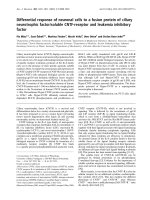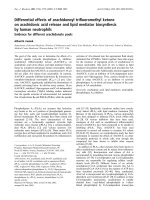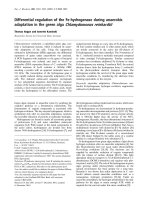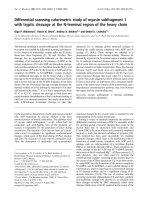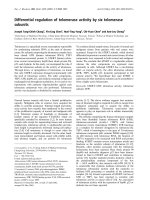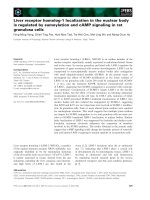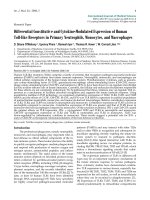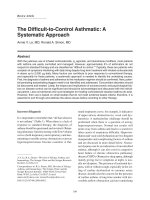Báo cáo y học: "Differential responsiveness to immunoablative therapy in refractory rheumatoid arthritis is associated with level and avidity of anti-cyclic citrullinated protein autoantibodies: a case study" pps
Bạn đang xem bản rút gọn của tài liệu. Xem và tải ngay bản đầy đủ của tài liệu tại đây (495.68 KB, 9 trang )
Open Access
Available online />Page 1 of 9
(page number not for citation purposes)
Vol 9 No 5
Research article
Differential responsiveness to immunoablative therapy in
refractory rheumatoid arthritis is associated with level and avidity
of anti-cyclic citrullinated protein autoantibodies: a case study
YK Onno Teng
1
, Robert J Verburg
1
, Kirsten N Verpoort
1
, Gwendolyn MP Diepenhorst
2
,
Ingeborg M Bajema
3
, Maarten JD van Tol
4
, Els CM Jol-van der Zijde
4
, Rene EM Toes
1
,
Tom WJ Huizinga
1
and Jacob M van Laar
5
1
Department of Rheumatology, Leiden University Medical Center, Albinusdreef 2, 2333 ZA Leiden, The Netherlands
2
Department of Immunopathology, Sanquin Research, Academic Medical Centre, Plesmanlaan 125, 1066 CX Amsterdam, The Netherlands
3
Department of Pathology, Leiden University Medical Center, Albinusdreef 2, 2333 ZA Leiden, The Netherlands
4
Department of Pediatrics, Leiden University Medical Center, Albinusdreef 2, 2333 ZA Leiden, The Netherlands
5
Musculoskeletal Research Group, Institute of Cellular Medicine, School of Clinical Medical Sciences, Newcastle University, 4th Floor, Catherine
Cookson Building, The Medical School, Framlington Place, Newcastle upon Tyne, NE2 4HH, United Kingdom
Corresponding author: Jacob M van Laar,
Received: 24 Jul 2007 Revisions requested: 28 Aug 2007 Revisions received: 7 Sep 2007 Accepted: 10 Oct 2007 Published: 10 Oct 2007
Arthritis Research & Therapy 2007, 9:R106 (doi:10.1186/ar2309)
This article is online at: />© 2007 Teng et al.; licensee BioMed Central Ltd.
This is an open access article distributed under the terms of the Creative Commons Attribution License ( />),
which permits unrestricted use, distribution, and reproduction in any medium, provided the original work is properly cited.
Abstract
In order to identify pathogenic correlates of refractory
rheumatoid arthritis (RA), antibodies against anti-cyclic
citrullinated protein (ACPAs) were investigated in RA patients in
whom the dysregulated immune system had been ablated by
high-dose chemotherapy (HDC) and autologous
haematopoietic stem cell transplantation (HSCT). Six patients
with refractory RA were extensively characterized in terms of
levels of total immunoglobulins, RA-specific autoantibodies
(ACPAs and rheumatoid factor) and antibodies against rubella,
tetanus toxoid (TT) and phosphorylcholine before and after HDC
plus HSCT. Additionally, the avidity of ACPAs was measured
before and after treatment and compared with the avidity of TT
antibodies following repeated immunizations. Synovial biopsies
were obtained by arthroscopy before HDC plus HSCT, and
analyzed by immunohistochemistry. In the three patients with
clinically long-lasting responses to HDC plus HSCT (median
423 days), significant reductions in ACPA-IgG levels after
therapy were observed (median level dropped from 215 to 34
arbitrary units/ml; P = 0.05). In contrast, stable ACPA-IgG levels
were observed in three patients who relapsed shortly after HDC
plus HSCT (median of 67 days). Clinical responders had ACPA-
IgG of lower avidity (r = 0.75; P = 0.08) and higher degree of
inflammation histologically (r = 0.73; P = 0.09). Relapse (after
38 to 530 days) in all patients was preceded by rising levels of
low avidity ACPA-IgG (after 30 to 388 days), in contrast to the
stable titres of high avidity TT antibodies. In conclusion, humoral
autoimmune responses were differentially modulated by
immunoablative therapy in patients with synovial inflammation
and low avidity ACPA-IgG autoantibodies as compared with
patients with high levels of high avidity ACPA-IgG. The distinct
clinical disease course after immunoablative therapy based on
levels and avidity of ACPA-IgG indicates that refractory RA is
not a single disease entity.
Introduction
Rheumatoid arthritis (RA) is a systemic, chronic and progres-
sive disease that requires long-term immunosuppressive treat-
ment, in which disease-modifying antirheumatic drugs
(DMARDs) play a central role. However, several studies have
shown that failure rates with conventional DMARD therapy can
reach 75% over a follow-up period of 5 years [1-3]. High-dose
chemotherapy (HDC) followed by autologous haematopoietic
stem cell transplantation (HSCT) is employed in the treatment
of patients with refractory autoimmune diseases, including
systemic lupus erythematosus (SLE), systemic sclerosis and
RA [4]. However, clinical efficacy of HDC plus HSCT varies
ACPA = anti-cyclic citrullinated protein antibody; AU = arbitrary units; DAS
44
= Disease Activity Score for 44 joints; DMARD = disease-modifying
antirheumatic drug; ELISA = enzyme-linked immunosorbent assay; HDC = high-dose chemotherapy; HSCT = haematopoietic stem cell transplanta-
tion; NaSCN = sodium thiocyanate; PC-IgM = anti-phosphorylcholine of the IgM isotype; RA = rheumatoid arthritis; RF = rheumatoid factor; RL-IgG
= rubella of the IgG isotype; TNF = tumour necrosis factor; TT = tetanus toxoid.
Arthritis Research & Therapy Vol 9 No 5 Teng et al.
Page 2 of 9
(page number not for citation purposes)
between different autoimmune diseases. A recent review of
the European Group for Blood and Marrow Transplantation/
European League Against Rheumatism registry for autologous
HSCT in autoimmune disease [5] showed that sustained
improvements were common in patients with systemic sclero-
sis and systemic lupus erythematosus, whereas in RA tempo-
rary improvements with subsequently relapsing disease was
the most common clinical course. Although the therapeutic
mechanism of HDC plus HSCT is conceptually similar for all
autoimmune diseases, it is currently unclear why HDC plus
HSCT exhibited inferior efficacy in RA.
A common finding in autoimmune diseases is activation of
autoreactive B lymphocytes, resulting in the formation of dis-
ease-specific autoantibodies [6,7]. Although the contribution
of autoantibodies to the pathogenesis of autoimmune dis-
eases is still unclear, many studies have demonstrated that the
presence of autoantibodies has diagnostic significance [8-10]
and is associated with worse disease outcome [11-14]. In RA
the presence of IgM rheumatoid factor (RF) and anti-cyclic cit-
rullinated protein antibody (ACPA)-IgG can be demonstrated
years before the clinical onset of RA [15], indicating that
humoral autoimmunity had been elicited before the develop-
ment of overt autoimmune disease. Additionally, their pres-
ence was associated with disease progression [16] and the
levels of ACPA-IgG predicted responsiveness to antirheu-
matic drugs [17]. However, the precise mechanisms underly-
ing the humoral autoimmune response in RA patients are still
poorly defined [18]. The majority of studies on ACPA-IgG have
investigated ACPA-IgG responses at a time when overt
autoimmune disease was already established. In these stud-
ies, treatment with conventional immunosuppressive drugs or
biological agents did not result in the elimination of circulating
autoantibodies [19]. The latter finding has been attributed to
the persistence of autoreactive, memory T and B lymphocytes,
the existence of long-lived autoreactive plasma cells [20,21],
or repeated activation and differentiation of new autoreactive
lymphocytes [22,23].
The present study exploited the profound anti-inflammatory,
anti-proliferative, and immunoablative effects of HDC plus
HSCT [24,25] to investigate whether humoral autoimmune
responses to ACPAs can be abrogated in refractory RA and
whether relapses are accompanied by newly generated
autoimmune responses.
Materials and methods
Patients and sample collection
Six patients with severe RA treated with HDC plus HSCT
were included in the study. From the original study cohort of
14 patients [26], eight patients were treated and extensively
followed up at Leiden University Medical Center. The present
study involves the six patients who were seropositive for RF-
IgM as well as ACPA-IgG, and for whom extensive clinical data
and experimental data were available. All patients had an
established diagnosis of RA based on American College of
Rheumatology criteria [27] with progressive erosive disease,
including large joint involvement, and were refractory to com-
bination therapy with DMARDs and, in four patients, with
tumour necrosis factor (TNF)-blocking agents. Heparinized
whole blood was collected and peripheral blood mononuclear
cells were isolated by density gradient centrifugation over
Ficoll-amidotrizoate (Leiden University Medical Center, Lei-
den, The Netherlands) and frozen in liquid nitrogen until analy-
sis. Peripheral blood mononuclear cells were collected every
3 months after treatment. Serum was collected and stored at
-20°C every month during the first year after treatment and
every 3 months during the second year after treatment. The
protocol was approved by the Leiden University Medical
Center Ethics Committee and all patients provided written
informed consent.
Immunological monitoring and clinical evaluations
RA disease activity was assessed by the Disease Activity
Score for 44 joints (DAS
44
) [28]. To correlate the results of
immunological monitoring with individual disease courses,
patients' clinical follow up was split in four consecutive peri-
ods, marked by the date of HSCT and by the first symptoms of
relapse after HSCT. Thus, four distinct periods were defined:
before HSCT, after HSCT ('nadir'), DMARD-free period after
HSCT ('DMARD-free') and after clinical relapse after trans-
plantation ('relapse'). Relapse was independently assessed by
two rheumatologists and necessitated reinstitution of conven-
tional antirheumatic treatment.
Immunohistochemical analysis
Synovial tissue specimens were obtained during arthroscopy,
which was performed before treatment on clinically affected
knees, as described previously [29]. At each procedure 16 to
20 pieces of synovial tissue were collected using 2.0 mm
grasping forceps (Storz, Tuttlingen, Germany) and embedded
in paraffin until analysis. Paraffin-embedded, serial sections
were stained with the following antibodies: rabbit anti-huCD3
(clone-SP7; Neomarkers, Fremont, CA, USA), mouse anti-
huCD79a (clone-JCD117; Dako, Glostrup, Denmark), mouse
anti-huCD20cy (clone-L26; Dako), mouse anti-human Ki-67
(clone-MIB-1; Dako), mouse anti-huCD68 (clone-KP1; Dako)
and mouse anti-huCD138 (clone B-B4, Serotec, Dusseldorf,
Germany). Sections were de-paraffinized by xylol, ethanol and
demi-water, followed by antigen retrieval via 10 minutes of
incubation of sections in boiling 1 mmol/l EDTA or 10 mmol/l
citrate buffer. After washing in demi-water and phosphate-
buffered saline, the appropriate titrated amount of antibody
was added and incubated for 60 minutes at room temperature.
Thereafter, sections were incubated with Mouse Envision or
Rabbit Envision conjugate (Dako) for 30 minutes. The colour-
ing reaction was completed with DAB substrate (Dako). Coun-
terstaining was performed with haematoxylin. Sections were
covered with Micromount mounting medium (Surgipath, Peter-
borough, UK).
Available online />Page 3 of 9
(page number not for citation purposes)
Semiquantitative scoring of inflammation
Stained sections were coded and randomly analyzed. All areas
of each biopsy section were scored blindly by two independ-
ent observers. Stained sections were scored semi-quantita-
tively from 0 to 4 (1 = lowest and 4 = highest level of
expression) [30]. The scoring system was calibrated for each
marker separately. Inflammation scores (ranging from 0 to 16)
were determined by the sum of four components: thickness
score for synovial lining (as scored by the number of cells con-
stituting the synovial lining) and semiquantitative scores (rang-
ing from 0 to 4) for polymorphonuclear cells, lymphocytes and
plasma cells [31]. Differences between observers were
resolved by mutual agreement.
Serum antibody levels
Serial serum samples were analyzed for levels of total immu-
noglobulins, RA-specific autoantibodies and physiological
antibodies. Total serum IgG and IgM levels were measured by
immunoturbidimetry using the COBAS-Integra 400/700/800
(Roche Diagnostics, Indianapolis, IA, USA), in accordance
with the manufacturer's guidelines.
A commercial ELISA was used to measure serum antibodies
against cyclic citrullinated peptides (Immunoscan RA, mark 2;
Euro-Diagnostica, Arnhem, The Netherlands), in accordance
with the manufacturer's instructions. Consistent with the inter-
national literature, we use the general term 'ACPA-IgG' to refer
to the entire family of autoantibodies to citrullinated proteins of
the IgG isotype. Serum RF-IgM was measured using a stand-
ardized ELISA [32]. Serum levels of rubella of the IgG isotype
(RL-IgG) were measured using the MEIA, Axsym
®
System
(Abbott Diagnostics, Abbott Park, IL, USA), in accordance
with the manufacturer's recommendations. RL-IgG levels were
considered positive when they were equal to or above 10 IU/
ml. Serum levels of anti-phosphorylcholine of the IgM isotype
(PC-IgM) were measured using ELISA, as described previ-
ously [33]. Dilutions of a serum pool, obtained from 200
healthy volunteers, were used as standard, which was arbitrar-
ily set at 100 units/ml of PC-IgM antibodies. Results were
related to this standard and expressed as arbitrary units (AU)/
ml.
Tetanus toxoid immunizations
Patients were given repeated immunizations with tetanus tox-
oid (TT), which was part of the DTPol vaccine (National Insti-
tute of Public Health and Environmental Protection, Bilthoven,
The Netherlands), containing diphtheria toxoid, tetanus toxoid
(five flocculation units), and inactivated poliovirus types 1, 2
and 3. Patients were boosted at 3, 4 and 5 months after HDC
plus HSCT when leucocyte counts had normalized. During the
period of immunizations, two patients (patients 4 and 5) had
restarted DMARD treatment because of a relapse of RA.
Serum was collected before each immunization and approxi-
mately 1 month after the last immunization and stored at -
20°C.
Avidity measurements
Avidity of ACPA-IgG and TT-IgG was measured by a modified
elution ELISA, as previously described [34]. Briefly, dilutions
of serum samples were allowed to interact with cyclic citrulli-
nated peptide or TT coated in the wells of microtitre plates.
After 1 hour incubation of 100 μl of diluted serum samples per
well, ELISA plates were washed. Thereafter, wells were incu-
bated with 150 μl of a variable molarity (range 0.5 to 6.0 mol/
l) of the chaotropic agent sodium thiocyanate (NaSCN; Merck,
Darmstadt, Germany) for 15 minutes at room temperature.
After vigorous washing, conjugate and colour reactions were
performed according to the corresponding ELISA described
above. The relative avidity index was defined as the molarity of
NaSCN at which 50% of the amount of IgG antibodies bound
to the coated antigen in the absence of NaSCN had been
eluted from the antigen.
Statistical analysis
Levels of autoantibodies, antibodies and immunohistochemi-
cal scores within patients were compared with their corre-
sponding pre-transplantation values by using the
nonparametric Wilcoxon signed rank test. Correlations
between synovial inflammation and ACPA-IgG level and
ACPA-IgG avidity, as well as correlations between ACPA-IgG
levels and C-reactive protein levels were tested using linear
regression analysis. Tests were considered significant at P ≤
0.05.
Results
Patients
As summarized in Table 1, all patients had persistent RA with
a median disease duration of 12 years (range 7 to 20 years)
and were positive for RF-IgM and ACPA-IgG, with a pre-trans-
plantation median RF-IgM level of 836 IU/ml (range 61 to
1,796 IU/ml) and ACPA-IgG level of 484 AU/ml (range 94 to
1,584 AU/ml). All patients were heterozygous for shared
epitope alleles. Patients had high disease activity before trans-
plantation, as indicated by a median DAS
44
score of 5.31
(range 4.58 to 7.24). After treatment with HDC plus HSCT all
patients exhibited an improvement in clinical disease activity,
with a lowest median DAS
44
of score 1.95 (range 0.89 to
3.80). Importantly, in two patients (patients 4 and 6) the
DAS
44
score did not decrease to below 2.4 (cut-off for active
disease according to European League Against Rheumatism
response criteria [35]). The improvements in DAS
44
score
were temporary, and patients were off DMARD therapy for a
median duration of 174 days (range 60 to 738 days). At the
time of relapse, when DMARDs were reinstituted, the median
DAS
44
score was 3.91 (range 2.62 to 5.16).
Immunoablative therapy resulted in selective reduction
of serum ACPA-IgG
Although clinical responses to HDC plus HSCT were hetero-
geneous, immunoablative therapy resulted consistently in
complete depletion of circulating B and T lymphocytes, and in
Arthritis Research & Therapy Vol 9 No 5 Teng et al.
Page 4 of 9
(page number not for citation purposes)
significant reductions of synovial inflammation (data previously
reported [26]). To investigate whether clinical responses were
associated with eradication of autoantibodies, we analyzed
the influence of immunoablative therapy on the levels of
ACPA-IgG and RF-IgM in comparison with antibody levels
against control antigens, respectively RL-IgG and PC-IgM
(selected because of the high prevalence of seropositivity in
the Dutch population), and the total IgG and total IgM levels
(Figure 1).
In three patients (patients 1 to 3) pre-transplantation levels of
ACPA-IgG (median 215 AU/ml, range 94 to 401 AU/ml) were
nearly completely eradicated after HDC plus HSCT (nadir
median 34 AU/ml, range <20 to 77 AU/ml; P = 0.05). In one
of these patients (patient 2) ACPA-IgG remained undetecta-
ble for the duration of follow up (757 days; Figure 1a). These
decreases contrasted with the stable levels of the RL-IgG con-
trol antibody in all patients (median pre-transplantation level
114 IU/ml [range 16 to 1,430 IU/ml] versus median nadir level
63 IU/ml [range 10 to 494 IU/ml], P = 0.63; Figure 1b). Immu-
noablative therapy also resulted in significant reductions in
both RF-IgM levels (median pre-transplantation level 1,125 IU/
ml [range 500 to 1,796 IU/ml] versus median nadir level 344
IU/ml [range 19 to 1,210 IU/ml, P = 0.043; Figure 1d) and PC-
IgM levels (median pre-transplantation level 109 AU/ml [range
19 to 340 AU/ml] and median nadir level 41 AU/ml [range 19
to 132 AU/ml, P = 0.043; Figure 1e) in the entire cohort.
Importantly, serum levels of total IgM and IgG were also
affected by HDC plus HSCT, notably IgM (Figure 1c,f). In indi-
vidual patients, the relative reduction in RF-IgM paralleled the
relative reduction in total IgM (median correlation coefficient
0.78, range 0.34 0.95), whereas the relative reduction in
ACPA-IgG was only weakly correlated with the relative reduc-
tions in total IgG levels (median correlation coefficient 0.33,
range 0.08 to 0.81; P = 0.07), which is indicative of nonselec-
tive depletion of RF-IgM.
Synovial inflammation is accompanied by ACPA-IgG
autoantibodies of low avidity
In the patients exhibiting a significant drop in ACPA-IgG
(patients 1 to 3) we observed a more pronounced decrease in
DAS
44
scores (0.89 to 1.95 versus 1.82 to 3.80; P = 0.27)
and more DMARD-free days (163 to 738 days versus 60 to
184 days, P = 0.12) after HDC plus HSCT as compared with
the three patients with stable ACPA-IgG levels (patients 4 to
6; Table 1). Therefore, we explored the possibility that persist-
ing synovial inflammation, as a putative source of ACPA-IgG
production, was associated with high and stable ACPA-IgG
levels.
Cross-sectional analysis of pre-transplantation synovial tissue
specimens revealed a heterogeneous degree of inflammation
involving various cell types (Figure 2a). Unexpectedly, a high
degree of synovial inflammation was correlated with relatively
low ACPA-IgG levels (r = 0.73, P = 0.09) and relatively low
avidity of ACPA-IgG (r = 0.75, P = 0.08; Figure 2b). These
findings were corroborated by the observation that, through-
out the complete study period, ACPA-IgG levels were strongly
correlated with serum C-reactive protein levels in the three
patients (patients 1 to 3) whose ACPA-IgG levels were nearly
completely eradicated after immunoablative therapy ('ACPA
responders': r = 0.56, P < 0.001; Figure 2c). The latter was
not the case for the three patients (patients 4 to 6) whose
ACPA-IgG remained relatively stable after immunoablative
therapy ('ACPA nonresponders': r = 0.027, P = 0.86; Figure
2d). Taken together, these data indicated that inflammation in
synovium corresponded with ACPA-IgG autoantibodies of low
avidity, reflecting an 'immature' autoimmune response. Moreo-
ver, ACPA-IgG levels in serum were not exclusively derived
from plasma cells in inflamed synovium, because patients with
low synovial inflammation had high circulating levels of ACPA-
IgG with relatively high avidity.
Table 1
Overview of study patients
Pre-transplantation characteristics Post-transplantation
characteristics
Age
(years)
Sex Disease
duration
(years)
RF-IgM
(IU/ml)
ACPA-IgG
(AU/ml)
CRP
(mg/l)
ESR
(mm/hour)
DAS
44
Lowest
DAS
44
DMARD-
free days
DAS
44
at
start or
DMARDs
Patient 1 51 Female 7 575 94 12 40 5.89 0.89 423 2.62
Patient 2 43 Male 11 1,096 215 57 126 5.13 1.95 163 4.10
Patient 3 42 Female 15 500 401 50 61 4.58 1.94 738 3.40
Patient 4 35 Female 9 61 577 2 49 4.77 3.52 60 5.16
Patient 5 45 Female 12 1,656 1,014 192 113 5.49 1.82 67 3.72
Patient 6 42 Female 20 1,796 1,584 59 64 7.24 3.80 184 4.95
ESR, erythrocyte sedimentation rate; DAS
44
, Disease Activity Score of 44 joints; DMARD, disease-modifying antirheumatic drug.
Available online />Page 5 of 9
(page number not for citation purposes)
After immunoablative therapy, humoral autoimmunity is
regenerated by ACPA-IgG autoantibodies of low avidity
Clinical relapses, which occurred between 38 and 530 days
after HDC plus HSCT, were preceded by a rise in ACPA-IgG
(30 to 217 days) and RF-IgM levels (30 to 388 days), respec-
tively (P = 0.028 and P = 0.043). To study the reactivation of
humoral autoimmunity after immunoablative therapy, we ana-
lyzed the avidity of reappearing ACPA-IgG autoantibodies by
dichotomizing patients according to their pre-transplantation
ACPA-IgG level and corresponding reduction after immuno-
ablative therapy ('ACPA responders' and 'ACPA nonrespond-
ers'; Figure 3a,b).
In the ACPA responders the decline in ACPA-IgG levels after
treatment and the rise preceding clinical relapse were associ-
ated with only minor changes in the avidity of ACPA-IgG
autoantibodies, which remained relatively low. However, in the
ACPA nonresponders the avidity of ACPA-IgG exhibited a
clear reduction (pre-transplantation median 1.04 M [range
0.69 to 2.91 M] versus median nadir after HDC plus HSCT
0.69 M [range 0.14 to 1.11 M]), reflecting low avidity ACPA-
IgG autoantibodies after immunoablative therapy. Overall, the
avidity of ACPA-IgG autoantibodies detectable after HDC
plus HSCT in both ACPA responders and nonresponders
consistently exhibited a decrease after HDC plus HSCT
(median 0.27 M, range 0.14 to 1.11 M) as compared with the
avidity before transplantation (median 0.69, range 0.39 to
2.91 M). Thereafter, despite relatively stable levels of ACPA-
IgG toward the time of relapse of RA, avidity maturation was
observed in the ACPA nonresponders, with a median of 1.12
M (range 1.12 to 3.60 M).
Collectively, these data indicate that clinically overt flares of
synovitis after HDC plus HSCT were preceded by the re-
emergence of low avidity ACPA-IgG autoantibodies, which is
indicative of a newly generated autoimmune response. Addi-
Figure 1
Effects of immunoablative therapyEffects of immunoablative therapy. Shown are the effects of immunoablative therapy on rheumatoid arthritis (RA)-specific autoantibody responses,
physiological antibody responses and total immunoglobulin levels. The individual disease course of patients was split in four consecutive time peri-
ods: before immunoablative therapy ('pre-TX'), the lowest antibody level after immunoablative therapy ('nadir'), the period after immunoablative ther-
apy without disease-modifying antirheumatic drug (DMARD) therapy ('DMARD free'), and the time of overt clinical flare of synovitis ('relapse').
Because the duration of the DMARD-free period varied for each patient (see Table 1), the presented levels are a mean of all observations during that
period. Each symbol corresponds to a different patient. (a) Titers of antibodies against anti-cyclic citrullinated protein (ACPA)-IgG. The cut-off for
ACPA-IgG is 25 arbitrary units (AU)/ml. In patient 1 a long-lasting undetectable level of ACPA-IgG was observed after high-dose chemotherapy plus
haematopoietic stem cell transplantation. Levels below the detection limit were arbitrarily assigned a value of 4 AU/mL to optimize the graphical rep-
resentation. (b) Titres of rubella of the IgG isotype (RL-IgG). (c) Titres of total circulating IgG. (d) Titres of rheumatoid factor (RF)-IgM.(e) Titres of
anti-phosphorylcholine of the IgM isotype (PC-IgM). (f) Titres of total circulating IgM.
Arthritis Research & Therapy Vol 9 No 5 Teng et al.
Page 6 of 9
(page number not for citation purposes)
tionally, during progression toward disease relapse after HDC
plus HSCT, avidity of ACPA-IgG autoantibodies returned to
pre-transplantation values.
Humoral memory responses to recall vaccination
antigen are not eradicated by immunoablative therapy
In general, humoral immunity to recall antigens depends on
activation of long-lasting memory B cells and plasma cells pro-
ducing high avidity antibodies. This contrasted with our find-
ings of ACPA-IgG autoantibodies, raising the question of
whether immunoablative therapy resulted in the eradication of
humoral memory. Therefore, we analyzed the effects of immu-
noablative therapy on memory responses before and after
repeated immunizations with the recall antigen TT.
As expected, the avidity of TT-IgG antibodies before transplan-
tation was high (median 3.10 M, range 2.70 to 3.30 M). In four
out of six patients, serum levels of TT-IgG increased following
repeated immunizations after HDC plus HSCT, but the avidity
remained high (median after first boost 3.0 M, range 2.70 to
3.30 M; after second boost 3.05 M, range 2.80 to 3.30 M;
after third boost 3.0 M, range 2.60 to 3.30 M; Figure 3c).
These data indicate that matured immune responses against a
recall antigen remained intact despite immunoablative therapy,
indicating a clear discrepancy between the humoral immunity
against recall antigens and citrullinated autoantigens.
Discussion
The aim of the present study was to investigate whether
humoral autoimmune responses in six refractory RA patients,
whose dysregulated immune system was ablated by HDC plus
Figure 2
Associations between synovial inflammation and circulating ACPA-IgG autoantibodiesAssociations between synovial inflammation and circulating ACPA-IgG autoantibodies. (a) Semiquantitative scores of individual patients before
immunoablative therapy, scoring synovial infiltration for CD68 expression (macrophages), CD138 expression (plasma cells), CD20 expression,
CD79a expression (B cells), CD3 expression (T-cells), Ki-67 expression (proliferation marker) and total inflammation. (b) Correlation of synovial
inflammation scores with serum levels of antibodies against anti-cyclic citrullinated protein (ACPA)-IgG (open symbols) and avidity of ACPA-IgG
(closed symbols) before immunoablative treatment. Each symbol corresponds to a distinct patient. (c) Correlation of serum levels of ACPA-IgG with
C-reactive protein (CRP) levels (r = 0.56, P < 0.001) during complete follow up in the three patients whose ACPA-IgG levels are susceptible to
immunoablative therapy ('ACPA responders'). (d) Correlation of serum levels of ACPA-IgG with CRP levels (r = 0.027, P = 0.86) during complete
follow up in the three patients whose ACPA-IgG levels remained stable after immunoablative therapy ('ACPA nonresponders'). AU, arbitrary units;
NaSCN, sodium thiocyanate.
Available online />Page 7 of 9
(page number not for citation purposes)
HSCT, underpinned their clinical responses. We showed that
reductions in ACPA-IgG levels were associated with clinically
prolonged responses to immunoablative therapy. The suscep-
tibility of ACPA-IgG to immunoablative therapy was associ-
ated with a high degree of synovial inflammation before
treatment and presence of ACPA-IgG autoantibodies of low
avidity. Importantly, overt clinical relapse in all six patients was
preceded by the reactivation of ACPA-IgG autoimmunity,
which consisted of low avidity antibodies indicative of a newly
generated ACPA-IgG response in these patients. The latter
occurred despite the observation that humoral immunity
against recall antigens (rubella and TT) remained unaffected
by immunoablative therapy.
Previous studies have reported that avidity of autoantibodies,
namely RF, anti-cardiolipin and anti-double stranded DNA
autoantibodies, can also vary between patients [36,37]. The
present study is the first to show that circulating ACPA-IgG
autoantibodies in RA patients differ in avidity. These differ-
ences were not reflected in DAS
44
scores, number or distribu-
tion of swollen and tender joints, or concentrations of
inflammatory markers (Table 1). We did observe a striking cor-
relation at baseline between the level of ACPA-IgG and their
avidity, although this correlation between level and avidity was
not observed after immunoablative therapy, indicating that this
finding was probably serendipidous. More importantly, we
demonstrated that in one group of patients (patients 1 to 3;
ACPA responders) the presence of low avidity ACPA-IgG
autoantibodies was associated with a high degree of synovial
inflammation, suggesting that production of low avidity ACPA-
IgG was derived from plasma cells in inflamed synovium. This
was further supported by the finding that ACPA-IgG levels
correlated well with C-reactive protein levels in these patients
and were effectively reduced by immunoablative therapy. In
contrast, clinical nonresponders had high serum levels of
ACPA-IgG with relatively high avidity and a low degree of syn-
ovial inflammation, suggesting that ACPA-IgG in these
patients (patients 4 to 6) was mainly produced by plasma cells
from bone marrow or other secondary lymphoid organs.
Together, these data suggest that ACPA-IgG levels in serum
reflect production at different sites (for example, inflamed syn-
ovium or bone marrow). Further studies are needed to investi-
gate whether ACPA-IgG autoantibodies of high avidity are
indeed produced by bone marrow derived plasma cells or
whether other mechanisms are responsible for the differences
in avidity of ACPA autoantibodies, for instance consumption of
high avidity ACPA-IgG autoantibodies at sites of synovial
inflammation.
By exploiting the antiproliferative and immunoablative proper-
ties of HDC plus HSCT, the present study was able to identify
two different phenotypes of refractory RA patients on the basis
of the level and avidity of circulating ACPA-IgG autoantibod-
ies. As a consequence, high serum levels of ACPA-IgG with
high avidity in RA patients can account for the seemingly par-
adoxical reports that high serum levels of ACPA-IgG predicted
unresponsiveness to TNF-blocking therapy [17] and, at the
same time, that decreases in ACPA-IgG levels are associated
with response to TNF-blocking therapy [16,38]. It is tempting
to speculate that the presence of high avidity ACPA-IgG
autoantibodies is characteristic of a category of RA patients
who are refractory or less responsive to immunosuppressive
treatment. In view of this hypothesis, it is noteworthy that one
patient, with low avidity ACPA-IgG autoantibodies before
transplantation, exhibited a long-lasting absence of detectable
ACPA-IgG levels after HDC plus HSCT. One previous study
Figure 3
Regeneration after immunoablative therapy of ACPA-IgG autoantibodies with low avidityRegeneration after immunoablative therapy of ACPA-IgG autoantibodies with low avidity. (a) Low avidity of antibodies against anti-cyclic citrullinated
protein (ACPA)-IgG (solid lines) before and after immunoablative therapy when autoimmunity is reactivated with rising levels of ACPA-IgG (dotted
lines) in the three 'ACPA responders'. Levels below the detection limit were arbitrarily assigned a value of 4 arbitrary units (AU)/ml to optimize the
graphical representation. Thick lines represent mean values. (b) Avidity of ACPA-IgG (solid lines) before and after immunoablative therapy in the
three 'ACPA nonresponders', in whom, despite relatively stable ACPA-IgG levels (dotted lines), reactivation of autoimmunity was accompanied by
the avidity maturation of ACPA-IgG autoantibodies. Thick lines represent mean values. (c) Avidity of tetanus toxoid (TT)-IgG (solid lines) before and
after immunoablative therapy in four patients. Increasing levels of TT-IgG (dotted lines) after repeated TT immunizations (see Materials and methods)
were accompanied by stably high avidity of TT-IgG, indicative of an intact humoral recall response despite immunoablative therapy. Thick lines repre-
sent mean values. DMARD, disease-modifying antirheumatic drug; NaSCN, sodium thiocyanate.
Arthritis Research & Therapy Vol 9 No 5 Teng et al.
Page 8 of 9
(page number not for citation purposes)
[39] reported eradication of serum ACPA-IgG in eight patients
with early RA receiving conventional antirheumatic treatment.
To our knowledge, however, the present study is the first to
show eradication of ACPA-IgG autoantibodies in refractory,
persistent RA (disease duration 7 years) that simultaneously
resulted in complete remission (lowest DAS
44
score 0.89),
with discontinuation of antirheumatic treatment for more than
1.5 years.
Another important observation was the discrepancy between
the humoral immune responses against recall antigens and cit-
rullinated autoantigens. The present study convincingly dem-
onstrated that the ability to mount a recall response against TT
remained intact after immunoablative therapy. The latter was
not the case for the response to citrullinated antigens, as indi-
cated by the nearly complete eradication of ACPA-IgG
autoantibodies in the ACPA responder group after HDC plus
HSCT, and by the decrease in ACPA-IgG avidity in the ACPA
nonresponder group, despite relatively stable levels of serum
ACPA-IgG. The latter strongly suggested that in the ACPA
nonresponder group, during the short DMARD-free period
after transplantation, a relapse of RA-related synovial inflam-
mation was heralded by a newly generated ACPA immune
response. However, our data could not discriminate between
ablation by HDC plus HSCT of autoreactive memory in the
ACPA nonresponder group and nonexistence of autoreactive
memory B cells.
Conclusion
This study demonstrated an association in individual RA
patients between clinical response and susceptibility of
ACPA-IgG autoantibodies to immunoablative therapy.
Response to HDC plus HSCT was associated with the pres-
ence of low avidity ACPA-IgG autoantibodies and histological
features of active synovitis. Additionally, clinical relapse after
HDC plus HSCT was preceded by the emergence of low avid-
ity ACPA-IgG autoantibodies, indicative of a newly generated
autoimmune response during synovial inflammation. These
data give novel insight into the humoral autoimmune response
in RA.
Competing interests
The authors declare that they have no competing interests.
Authors' contributions
YKOT contributed to the acquisition of data, analysis and inter-
pretation of data, and preparation of the manuscript. RJV con-
tributed to the design of the study and acquisition of the data.
KNV contributed to the acquisition of data. GWND contrib-
uted to the acquisition of data. IMB contributed to the acquisi-
tion and analysis of data. MJDvT contributed to the
interpretation of data. CMJ-vZ contributed to the acquisition,
analysis and interpretation of the data. REMT contributed to
the interpretation of the data. TWJH contributed to interpreta-
tion of data. JMvL contributed to the design of the study, acqui-
sition, analysis and interpretation of the data, and preparation
of the manuscript.
Acknowledgements
We thank Dr JK Sont of the Department of Medical Decision Making for
his advice on the statistical analyses.
Financial support for this study was obtained from the Dutch Arthritis
Association (NR 99-1-301). The work of YKO Teng was supported by
an Agiko grant from The Netherlands Organization for Scientific
Research.
References
1. Maetzel A, Wong A, Strand V, Tugwell P, Wells G, Bombardier C:
Meta-analysis of treatment termination rates among rheuma-
toid arthritis patients receiving disease-modifying anti-rheu-
matic drugs. Rheumatology (Oxford) 2000, 39:975-981.
2. Aletaha D, Smolen JS: Effectiveness profiles and dose depend-
ent retention of traditional disease modifying antirheumatic
drugs for rheumatoid arthritis. An observational study. J
Rheumatol 2002, 29:1631-1638.
3. van der Kooij SM, Vries-Bouwstra JK, Goekoop-Ruiterman YP, van
Zeben D, Kerstens PJ, Gerards AH, van Groenendael JH, Hazes
JM, Breedveld FC, Allaart CF, Dijkmans BA: Limited efficacy of
conventional DMARDs after initial methotrexate failure in
patients with recent onset rheumatoid arthritis treated accord-
ing to the Disease Activity Score. Ann Rheum Dis 2007,
66:1356-1362.
4. Burt RK, Marmont A, Oyama Y, Slavin S, Arnold R, Hiepe F, Fassas
A, Snowden J, Schuening F, Myint H, et al.: Randomized control-
led trials of autologous hematopoietic stem cell transplanta-
tion for autoimmune diseases: the evolution from
myeloablative to lymphoablative transplant regimens. Arthritis
Rheum 2006, 54:3750-3760.
5. Tyndall A, Saccardi R: Haematopoietic stem cell transplantation
in the treatment of severe autoimmune disease: results from
phase I/II studies, prospective randomized trials and future
directions. Clin Exp Immunol 2005, 141:1-9.
6. Lipsky PE: Systemic lupus erythematosus: an autoimmune
disease of B cell hyperactivity. Nat Immunol 2001, 2:764-766.
7. Avouac J, Gossec L, Dougados M: Diagnostic and predictive
value of anti-cyclic citrullinated protein antibodies in rheuma-
toid arthritis: a systematic literature review. Ann Rheum Dis
2006, 65:845-851.
8. Nishimura K, Sugiyama D, Kogata Y, Tsuji G, Nakazawa T, Kawano
S, Saigo K, Morinobu A, Koshiba M, Kuntz KM, et al.: Meta-analy-
sis: diagnostic accuracy of anti-cyclic citrullinated peptide anti-
body and rheumatoid factor for rheumatoid arthritis. Ann
Intern Med 2007, 146:797-808.
9. Kurien BT, Scofield RH: Autoantibody determination in the
diagnosis of systemic lupus erythematosus. Scand J Immunol
2006, 64:227-235.
10. Lyons R, Narain S, Nichols C, Satoh M, Reeves WH: Effective use
of autoantibody tests in the diagnosis of systemic autoim-
mune disease. Ann N Y Acad Sci 2005, 1050:217-228.
11. Harris ML, Rosen A: Autoimmunity in scleroderma: the origin,
pathogenetic role, and clinical significance of autoantibodies.
Curr Opin Rheumatol 2003, 15:778-784.
12. Hietarinta M, Lassila O: Clinical significance of antinuclear anti-
bodies in systemic rheumatic diseases. Ann Med 1996,
28:283-291.
13. van der Helm-van Mil AH, Verpoort KN, Breedveld FC, Toes RE,
Huizinga TW: Antibodies to citrullinated proteins and differ-
ences in clinical progression of rheumatoid arthritis. Arthritis
Res Ther 2005, 7:R949-R958.
14. Swaak T, Smeenk R: Clinical significance of antibodies to dou-
ble stranded DNA (dsDNA) for systemic lupus erythematosus
(SLE). Clin Rheumatol 1987:56-73.
15. Nielen MM, van Schaardenburg D, Reesink HW, van de Stadt RJ,
van Der Horst-Bruinsma IE, de Koning MH, Habibuw MR, Vanden-
broucke JP, Dijkmans BA: Specific autoantibodies precede the
symptoms of rheumatoid arthritis: a study of serial measure-
ments in blood donors. Arthritis Rheum 2004, 50:380-386.
Available online />Page 9 of 9
(page number not for citation purposes)
16. Berglin E, Johansson T, Sundin U, Jidell E, Wadell G, Hallmans G,
Rantapaa-Dahlqvist S: Radiological outcome in rheumatoid
arthritis is predicted by presence of antibodies against cyclic
citrullinated peptide before and at disease onset, and by IgA-
RF at disease onset. Ann Rheum Dis 2006, 65:453-458.
17. Braun-Moscovici Y, Markovits D, Zinder O, Schapira D, Rozin A,
Ehrenburg M, Dain L, Hoffer E, Nahir AM, Balbir-Gurman A: Anti-
cyclic citrullinated protein antibodies as a predictor of
response to anti-tumor necrosis factor-alpha therapy in
patients with rheumatoid arthritis. J Rheumatol 2006,
33:497-500.
18. Martin F, Chan AC: B cell immunobiology in disease: evolving
concepts from the clinic. Annu Rev Immunol 2006, 24:467-496.
19. Mikuls TR, O'Dell JR, Stoner JA, Parrish LA, Arend WP, Norris JM,
Holers VM: Association of rheumatoid arthritis treatment
response and disease duration with declines in serum levels
of IgM rheumatoid factor and anti-cyclic citrullinated peptide
antibody. Arthritis Rheum 2004, 50:3776-3782.
20. Manz RA, Thiel A, Radbruch A: Lifetime of plasma cells in the
bone marrow. Nature 1997, 388:133-134.
21. Hoyer BF, Moser K, Hauser AE, Peddinghaus A, Voigt C, Eilat D,
Radbruch A, Hiepe F, Manz RA: Short-lived plasmablasts and
long-lived plasma cells contribute to chronic humoral autoim-
munity in NZB/W mice. J Exp Med 2004, 199:1577-1584.
22. Verpoort KN, Jol-van der Zijde CM, Papendrecht-van der Voort EA,
Ioan-Facsinay A, Drijfhout JW, van Tol MJ, Breedveld FC, Huizinga
TW, Toes RE: Isotype distribution of anti-cyclic citrullinated
peptide antibodies in undifferentiated arthritis and rheumatoid
arthritis reflects an ongoing immune response. Arthritis
Rheum 2006, 54:3799-3808.
23. Reparon-Schuijt CC, van Esch WJ, van Kooten C, Schellekens
GA, de Jong BA, van Venrooij WJ, Breedveld FC, Verweij CL:
Secretion of anti-citrulline-containing peptide antibody by B
lymphocytes in rheumatoid arthritis. Arthritis Rheum 2001,
44:41-47.
24. Storek J, Ferrara S, Rodriguez C, Saxon A: Recovery of mononu-
clear cell subsets after bone marrow transplantation: over-
abundance of CD4+CD8+ dual-positive T cells reminiscent of
ontogeny. J Hematother 1992, 1:303-316.
25. Storek J, Ferrara S, Ku N, Giorgi JV, Champlin RE, Saxon A: B cell
reconstitution after human bone marrow transplantation: reca-
pitulation of ontogeny?
Bone Marrow Transplant 1993,
12:387-398.
26. Verburg RJ, Kruize AA, van den Hoogen FH, Fibbe WE, Petersen
EJ, Preijers F, Sont JK, Barge RM, Bijlsma JW, van de Putte LB, et
al.: High-dose chemotherapy and autologous hematopoietic
stem cell transplantation in patients with rheumatoid arthritis:
results of an open study to assess feasibility, safety, and
efficacy. Arthritis Rheum 2001, 44:754-760.
27. Arnett FC, Edworthy SM, Bloch DA, McShane DJ, Fries JF, Cooper
NS, Healey LA, Kaplan SR, Liang MH, Luthra HS, et al.: The Amer-
ican Rheumatism Association 1987 revised criteria for the
classification of rheumatoid arthritis. Arthritis Rheum 1988,
31:315-324.
28. van der Heijde DM, van 't HM, van Riel PL, van de Putte LB: Devel-
opment of a disease activity score based on judgment in clin-
ical practice by rheumatologists. J Rheumatol 1993,
20:579-581.
29. van Oosterhout M, Levarht EW, Sont JK, Huizinga TW, Toes RE,
van Laar JM: Clinical efficacy of infliximab plus methotrexate in
DMARD naive and DMARD refractory rheumatoid arthritis is
associated with decreased synovial expression of TNF alpha
and IL18 but not CXCL12. Ann Rheum Dis 2005, 64:537-543.
30. Kraan MC, Haringman JJ, Post WJ, Versendaal J, Breedveld FC,
Tak PP: Immunohistological analysis of synovial tissue for dif-
ferential diagnosis in early arthritis. Rheumatology (Oxford)
1999, 38:1074-1080.
31. Tak PP, Smeets TJ, Daha MR, Kluin PM, Meijers KA, Brand R,
Meinders AE, Breedveld FC: Analysis of the synovial cell infil-
trate in early rheumatoid synovial tissue in relation to local dis-
ease activity. Arthritis Rheum 1997, 40:217-225.
32. van Esch WJ, Reparon-Schuijt CC, Levarht EW, van Kooten C,
Breedveld FC, Verweij CL: Differential requirements for induc-
tion of total immunoglobulin and physiological rheumatoid
factor production by human peripheral blood B cells. Clin Exp
Immunol 2001, 123:496-504.
33. Padilla ND, Ciurana C, van Oers J, Ogilvie AC, Hack CE: Levels of
natural IgM antibodies against phosphorylcholine in healthy
individuals and in patients undergoing isolated limb perfusion.
J Immunol Methods 2004, 293:1-11.
34. Kroon FP, van Tol MJ, Jol-van der Zijde CM, van Furth R, van Dissel
JT: Immunoglobulin G (IgG) subclass distribution and IgG1
avidity of antibodies in human immunodeficiency virus-
infected individuals after revaccination with tetanus toxoid.
Clin Diagn Lab Immunol 1999, 6:352-355.
35. van Gestel AM, Prevoo ML, 't Hof MA, van Rijswijk MH, van de
Putte LB, van Riel PL: Development and validation of the Euro-
pean League Against Rheumatism response criteria for rheu-
matoid arthritis. Comparison with the preliminary American
College of Rheumatology and the World Health Organization/
International League Against Rheumatism Criteria. Arthritis
Rheum 1996, 39:34-40.
36. Newkirk MM, Fournier MJ, Shiroky J: Rheumatoid factor avidity in
patients with rheumatoid arthritis: identification of pathogenic
RFs which correlate with disease parameters and with the
gal(0) glycoform of IgG. J Clin Immunol 1995, 15:250-257.
37. Harris EN, Pierangeli S: Anticardiolipin antibodies: specificity
and function. Lupus 1994, 3:217-222.
38. Alessandri C, Bombardieri M, Papa N, Cinquini M, Magrini L, Tin-
cani A, Valesini G: Decrease of anti-cyclic citrullinated peptide
antibodies and rheumatoid factor following anti-TNFalpha
therapy (infliximab) in rheumatoid arthritis is associated with
clinical improvement. Ann Rheum Dis 2004, 63:1218-1221.
39. Ronnelid J, Wick MC, Lampa J, Lindblad S, Nordmark B, Klareskog
L, van Vollenhoven RF: Longitudinal analysis of citrullinated pro-
tein/peptide antibodies (anti-CP) during 5 year follow up in
early rheumatoid arthritis: anti-CP status predicts worse dis-
ease activity and greater radiological progression. Ann Rheum
Dis 2005, 64:1744-1749.
